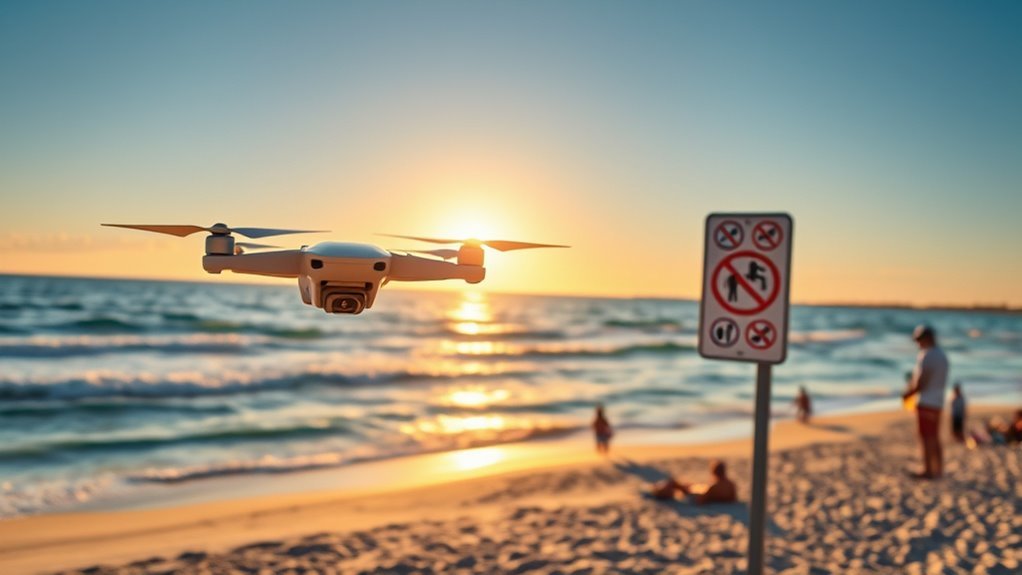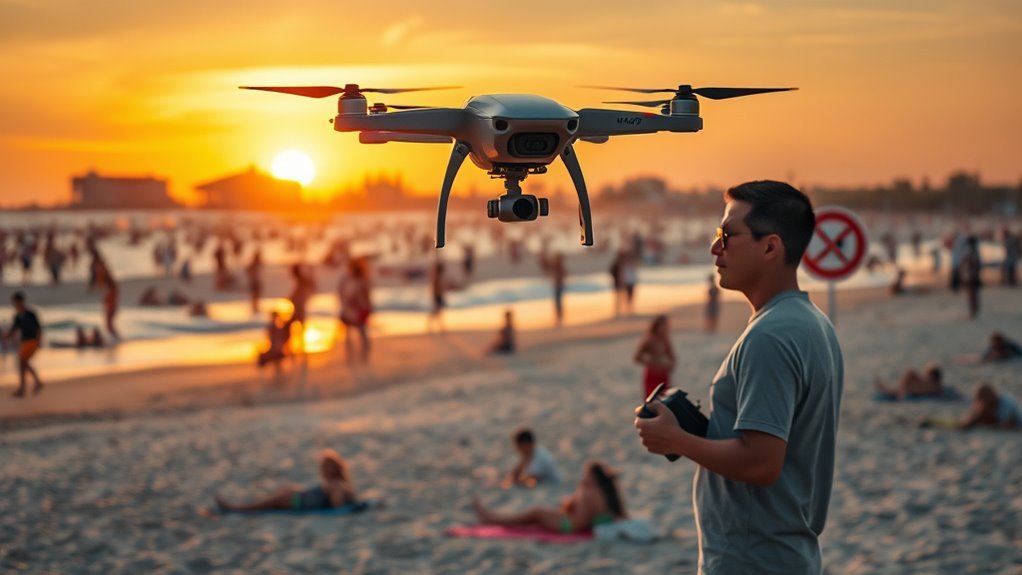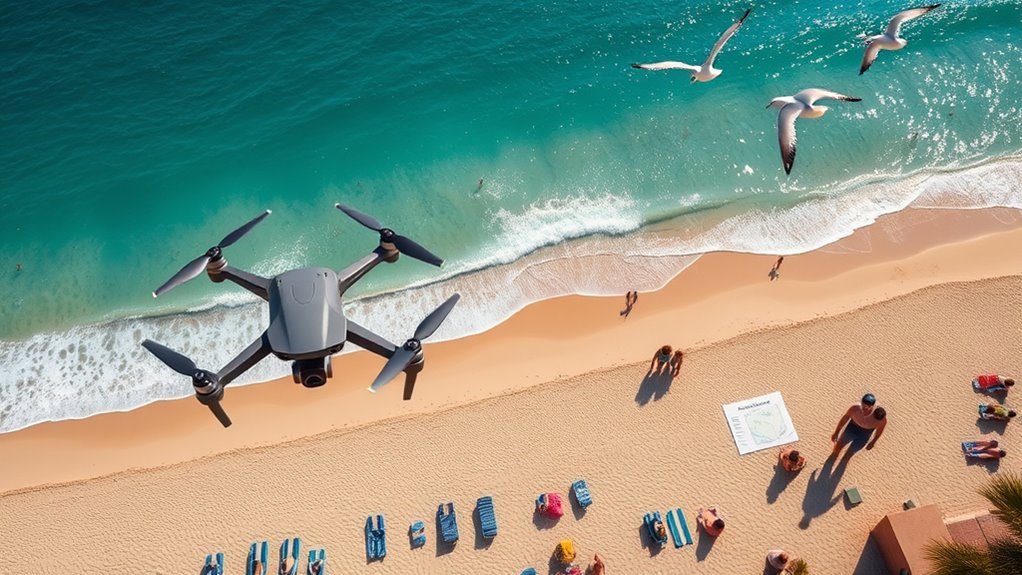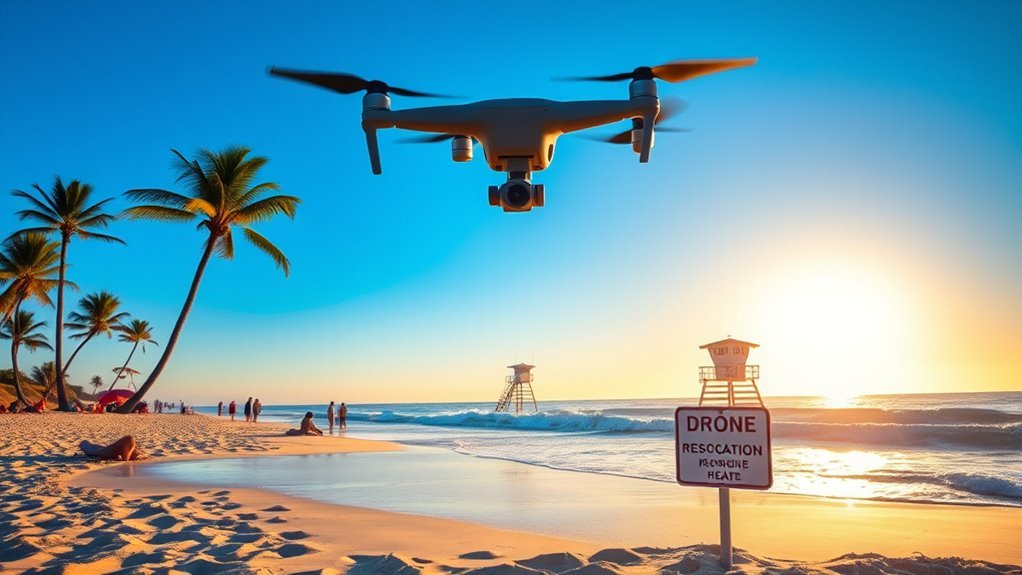To fly your drone legally at public beaches, you need to understand local drone laws, which may include no-fly zones and altitude limits. Make sure your drone is registered with the appropriate aviation authority and keep those documents accessible during flights. Depending on your purpose, you might need permits for recreational or commercial use. Always respect privacy by maintaining distance from people and property. There’s more to learn about best practices and specific regulations that could help your flying experience.
Understanding Local Drone Laws

Before you take to the skies with your drone, it’s crucial to understand the local laws that govern their use. Each region has its own set of local regulations that dictate where and how you can operate your drone. Ignoring these rules can lead to fines or other penalties enforced by local enforcement agencies. These agencies monitor compliance to promote safety and privacy for all beachgoers. Research the specific drone laws applicable to your area, including any no-fly zones or restrictions on altitude. Being informed not only protects your freedom to fly but also fosters responsible drone usage. So, before launching, make certain you’re aware of the legal landscape to enjoy your aerial adventures without unnecessary complications.
Registering Your Drone

Understanding local drone laws is just the first step; registering your drone is a key requirement for legal operation in many jurisdictions. Failing to register could result in hefty fines and restricted access to public spaces.
To guarantee you’re compliant, remember these points about drone registration:
- Check if your drone requires registration based on weight and purpose.
- Complete the registration process through your local aviation authority.
- Keep your registration documents accessible during flights.
- Renew your registration as mandated by local laws.
- Understand that registration doesn’t exempt you from other legal requirements.
Obtaining Necessary Permits

While registering your drone is essential, obtaining the necessary permits is equally important for flying legally. You’ll need to complete a permit application, which varies by location, as each beach has its own regulations. Always check specific beach regulations before planning your flight to guarantee compliance.
| Permit Type | Description |
|---|---|
| Commercial Use | Required for any business-related flights. |
| Recreational Use | May be needed for personal drone flying. |
| Special Events | Necessary for flying during events or gatherings. |
Respecting Privacy and Safety Regulations
As you prepare to fly your drone, it’s crucial to respect privacy and safety regulations to guarantee a responsible flying experience. Ignoring these concerns can lead to serious consequences for both you and those around you. Here are key points to keep in mind:
- Always maintain a safe distance from people and property.
- Avoid flying over private property without permission to address privacy concerns.
- Respect no-fly zones, especially near sensitive areas.
- Familiarize yourself with local laws and regulations to guarantee compliance with safety measures, as well as understanding NDAA compliance to ensure your equipment meets security standards.
- Be aware of weather conditions that may impact your flight’s safety.
- Understanding drone regulations is essential to ensure you are flying legally and safely.
Best Practices for Flying at the Beach
When you decide to fly your drone at the beach, it’s important to keep specific best practices in mind to secure a safe and enjoyable experience. Adhering to drone etiquette and being aware of beach conditions can enhance your flight while protecting others.
| Best Practice | Description | Importance |
|---|---|---|
| Check Regulations | Review local laws and guidelines | Guarantees legal compliance |
| Observe Weather | Monitor wind and weather conditions | Safeguards flight stability |
| Respect Others | Maintain distance from people | Protects privacy and safety |
| Avoid Wildlife | Stay clear of birds and marine life | Preserves local ecosystems |
| Fly Responsibly | Keep your drone within sight | Enhances safety and control |
Additionally, always ensure you have the necessary registration and permits to fly your drone legally in public spaces. Flying near government buildings or crowded areas without authorization can lead to serious penalties.
Frequently Asked Questions
Can I Fly My Drone During Beach Events or Festivals?
You might think capturing festival moments with your drone is a breeze, but it’s essential to check drone regulations. Always seek festival permissions first, ensuring your aerial escapades remain thrilling yet compliant with local rules.
What Are the Penalties for Flying a Drone Illegally at the Beach?
If you fly your drone illegally at the beach, you could face civil penalties or federal fines. It’s essential to understand local regulations to avoid these consequences and enjoy your freedom responsibly.
Is There a Maximum Altitude I Should Maintain While Flying?
Imagine a bird soaring through the sky. To guarantee safe flying, you should maintain a drone altitude below 400 feet. This keeps you clear of manned aircraft and guarantees a responsible, enjoyable experience for everyone.
How Do I Report Someone Flying a Drone Illegally?
If you see someone flying a drone illegally, follow local drone regulations by documenting the incident and contacting authorities. Familiarize yourself with reporting procedures to guarantee proper action is taken against the violator.
Are There Specific Beach Areas Where Drones Are Prohibited?
Imagine a soaring eagle, yet not every sky’s open. Some beaches have no fly zones due to local regulations. Check your area’s rules to verify you’re flying freely and legally, embracing the skies responsibly.

